Eastern Milk Snake Lampropeltis triangulum
Alternate names: Eastern Milksnake
by Jeff LeClere
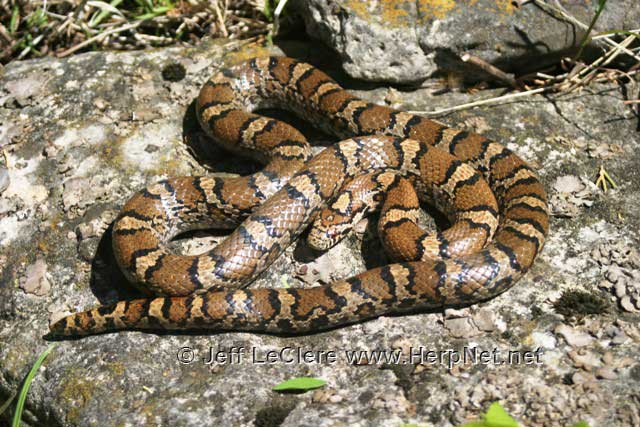
Status
PROTECTED and Species of Greatest Conservation Need. It is illegal to kill or collect this species by law in Iowa. Eastern milk snakes are common, but since they are very secretive, they are seldom seen by the general public.
Description
Harmless to humans. The eastern milk snake is a medium sized Iowa snake that is 24 – 52 inches in length, but quite often maintains a slender build. Although this snake’s blotched pattern remains consistent, its general coloration is quite variable. Some specimens can be beautifully light colored, having a light gray or brown ground color and bright to rusty red body blotches. Others can look a lot like fox snakes having an overall brown coloration. Still, others can be a dark gray with little or no difference in color between the ground color and blotches, only the black borders (which are always present) indicate the presence of blotches.
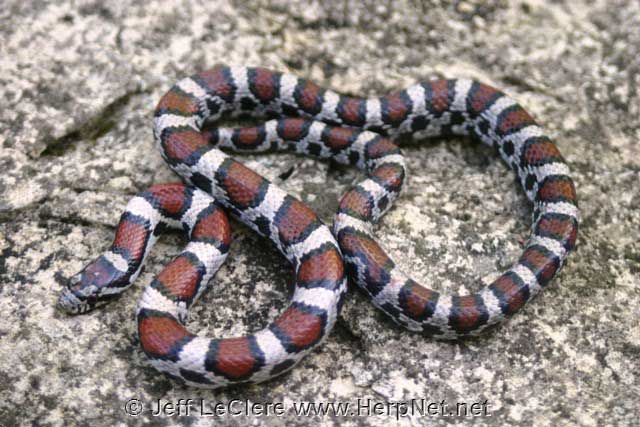
There is an alternating row (sometimes two) of lateral spots on the sides. These vary in size, but are never as big as the dorsal blotches. The belly is white with clusters of black checkers scattered randomly about the venter. Often there is a pink or peach wash to the general ventral coloration. There is a light V or Y marking at the back of the head, but this is sometimes replaced by a light spot. The snout is usually white. The scales are smooth and the anal plate is single.
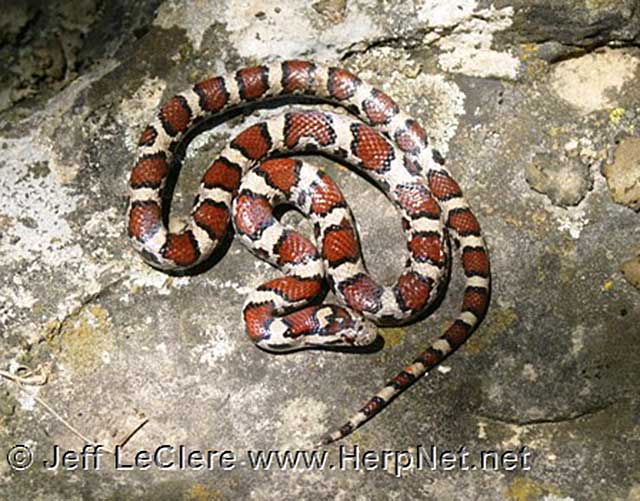
Subspecies
No subspecies of the eastern milk snake are currently recognized. Formerly, two subspecies of milk snake were listed in Iowa, the red milk snake, Lampropeltis triangulum syspila, and the eastern milk snake, Lampropeltis triangulum triangulum.
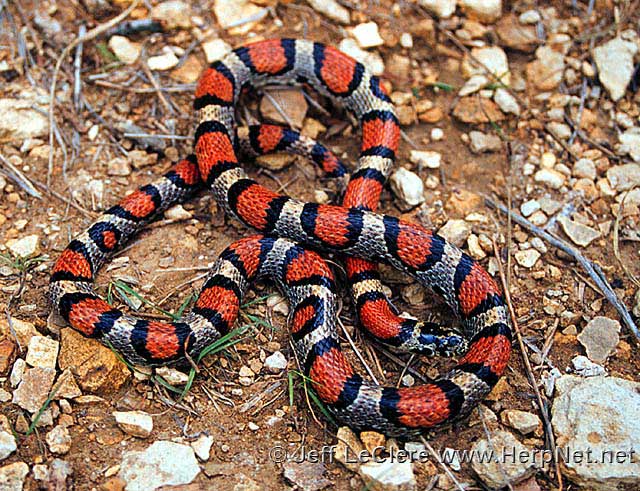
A few specimens from northwestern Iowa are similar in appearance to the western milk snake, Lampropeltis gentilis.
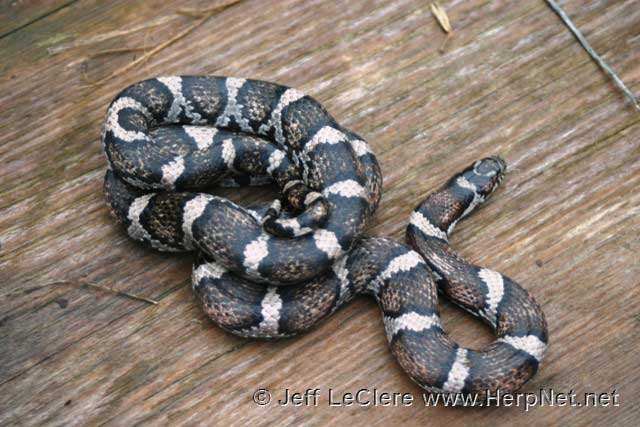
Range
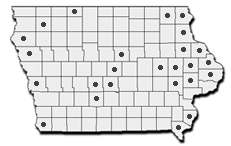
Eastern milk snakes are found almost statewide in Iowa.
Habitat
Rocky hillsides provide the favored habitat in Iowa, at least that is where they are most often seen. Farmlands, grasslands bordering woodlands, and rock outcroppings, especially near waterways, are used. Eastern milk snakes are also found in woodlands and in the Loess Hills, but here they are rarely discovered unless they are found hit on the road or crossing a trail.

Habits
Eastern milk snakes are diurnal in the spring and fall becoming largely nocturnal in summer. They are very secretive and are rarely found in the open. They spend much of their time hiding beneath logs, rocks, boards, bark, and other debris. Only on a few occasions have I observed eastern milk snakes sunning in the open. Occasionally, they may climb in search of food or to escape severe flooding. My cousin found a nice eastern milk snake (nice large, bright, red blotches with yellow interspaces) in Johnson County swimming into shore during a flood. There were many trees about 20 meters away from shore. This was undoubtedly where the snake came from.
Eastern milk snakes endure many temperature extremes hiding under tin or rocks in hot weather when other species of snakes are underground, or hiding beneath rocks or boards with water or mud under them. Wild caught eastern milk snakes can look extremely worn having many scars, skin lesions, (especially before a shed) or stub tails.
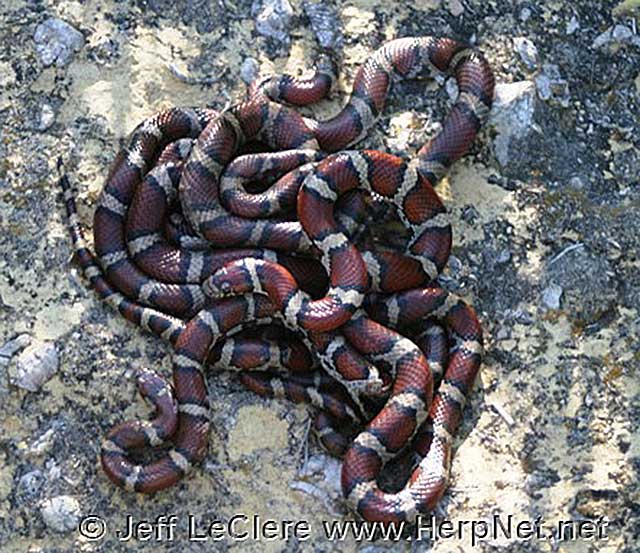
This snake is active from April to September. Most eastern milk snakes move away from their rocky outcropping or mammal burrow hibernacula to farms and grasslands with suitable food and cover during the summer. A few remain near their overwintering spots, however.
Mating takes place in spring or early summer. The female lays about 10 eggs in an area selected for its high humidity and warmth. Incubation lasts from 28 – 39 days. In the fall, the young eastern milk snakes hatch from their eggs. They are 5 – 10 inches at hatching and have the most spectacular coloration they will ever have. They are bright white or gray with rich pure red blotches. Eastern milk snakes are usually apt to coil, strike and bite when captured, especially during cold weather. They strike with a short, forced hiss and try to quickly slither away and under cover when they get the chance. Even after they are picked up, they may casually turn and chew on fingers or the arm of the person holding it. They also vibrate their tails and release musk.
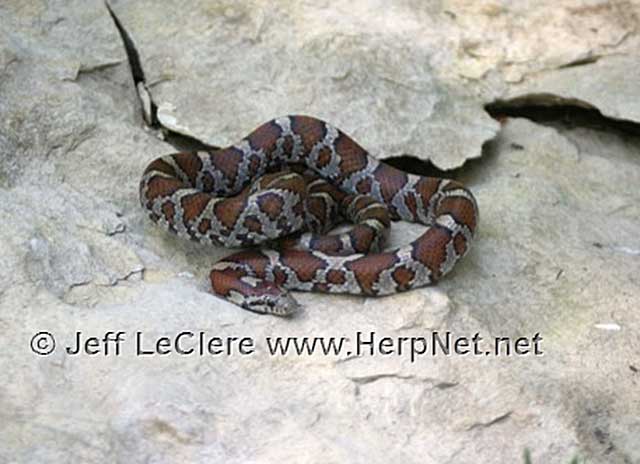
Food
Eastern milk snakes feed on a wide variety of animals including mice, reptiles, amphibians, invertebrates, reptile eggs, birds and birds’ eggs. They are a type of kingsnake and will consume venomous snakes when they chance upon them. They are at least partially immune to the venom of the venomous snakes in their range and many venomous serpents will use defensive tactics other than biting to protect themselves from kingsnakes. Young snakes comprise a large portion of a baby eastern milk snake’s diet, but they are not found to be the most significant food item for adults (Breckenridge, 1944). Adults consume mainly rodents. Eastern milk snakes are constrictors. Eastern milk snakes are so named because it was once believed that these snakes would enter barns and steal milk from cows. This is false; snakes only drink water. They would become sick if they were to drink cow’s milk. Snakes also have sharp teeth; no cow would stand still for that! The eastern milk snakes were in the barns actually helping the farmers by looking for rodents to eat.